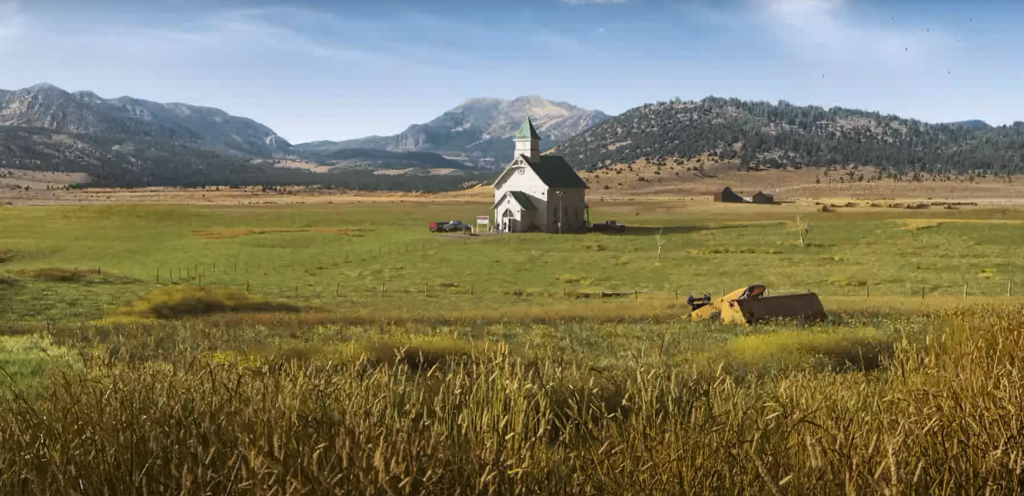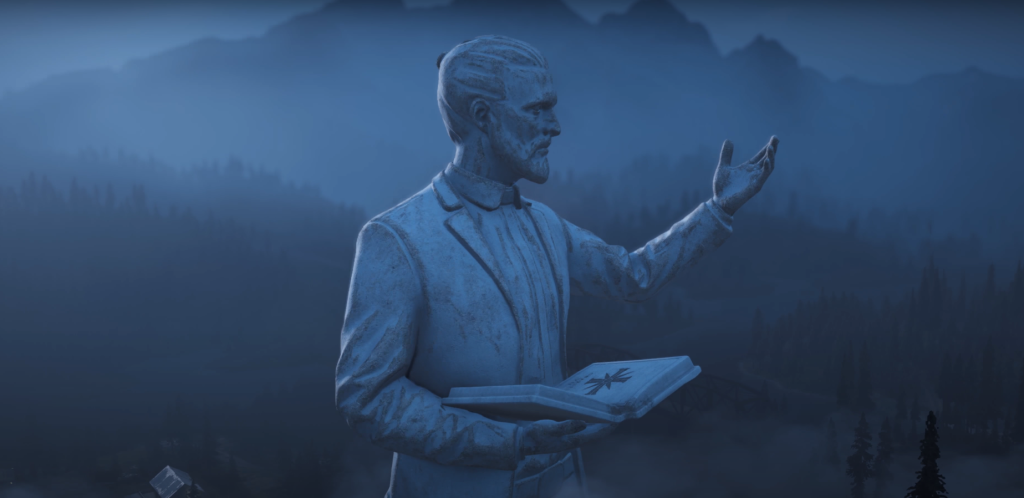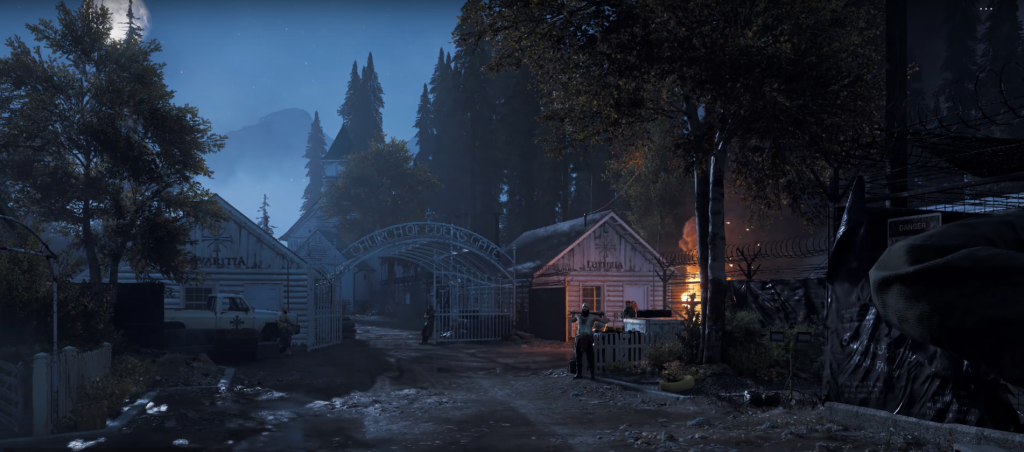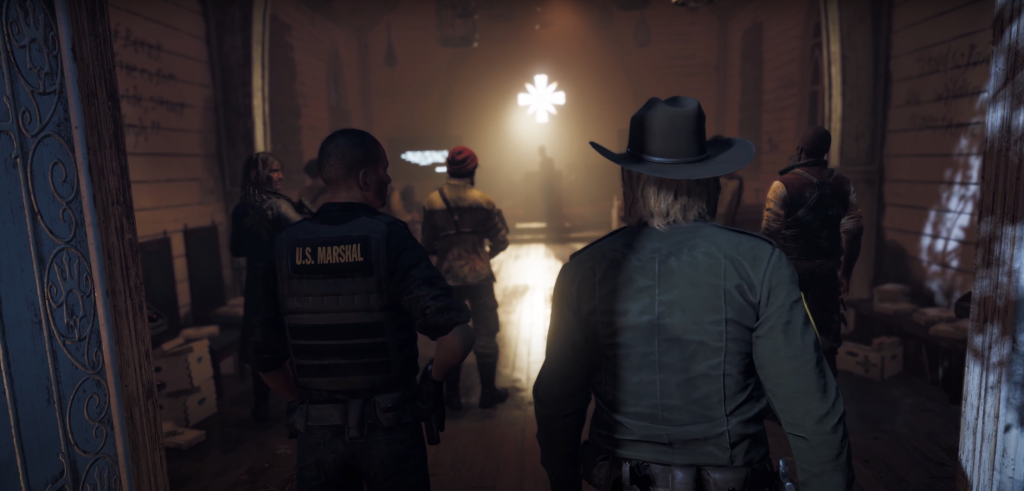The task saw us choose a game environment of our choice and analyse different aspects of it, discussing areas that make it good, areas that could be improved and our overall thoughts about it.
CHOOSING AN ENVIRONMENT
I decided to analyse the opening environment from Far Cry 5, set in the fictional Hope County in Montana, United States, as I recently started playing its sequel, Far Cry New Dawn.
The first 11 minutes of gameplay, linked at the bottom of this blog post, is used to provide the player with the initial lore of the game and establishing the key characters and antagonists that the player will meet within their playthrough. In the screenshots below, I believe that a story is told to the viewer, even without the additional voice-over that plays in the opening cutscene.
The first initial shot that the player sees is a church, surrounded by acres of open field and mountainous terrain that can be seen in the background. The church is painted in relatively neutral tones, with white and green making up the majority of its colour palette, with white often having ties to innocence and purity whilst green is often linked to new beginnings and growth (Cherry, 2021 and Cherry, 2019). This may be an attempt at garnering trust through the use of colour theory and the meaning behind certain colours or could be entirely a coincidence.
The background helps to develop how rural this location is, with the only other buildings in the shot appearing towards the right of the church and extremely small. In addition to this with the mountainous terrain behind the church and the other buildings, no other structure can be seen in the shot, which helps the player grasp how remote this area truly is.

As the player progresses, the lighting transitions to moonlight, creating a darker and more dramatic feel to the scene in comparison to the opening shot. The lighting in the opening shot is warm and bright, basking the church in sunlight. The lighting of the church helps draw the player’s attention further to the centre, as the warm lighting makes the white paint of the church appear brighter, almost as if it is framed by a spotlight.
In comparison, the lighting is now significantly less warm and bright and arguably feels much colder, uninviting and dangerous. The moonlight highlights the back of the statue that is seen in the centre of the frame and remains in the centre of the player’s sight for a fair amount of time as they move past it. I believe that this would translate across to a new player that the man represented in the stone statue is of great importance to the people in this area, which would additionally spark the question of “Why is he so important?” due to the relatively limited knowledge they have on the character at this point in the narrative.
Furthermore, the player can grasp this individuals importance based on the scale of this statue. In the image and the gif below, we can see that the statue is higher than a multitude of tall trees and clouds and is seen to be in line with the mountains in the background. The trees seen in the game are likely to be “Ponderosa Pine”, a tree that is incredibly common in Montana and has a height range from 50ft to 180ft (15.24 meters to 54.864 meters) (Collard, 2020) – the statue clears this height range entirely which wordlessly translates across the importance and power of this character.

![Far Cry 5: The Father - Cult Vignette | Ubisoft [US]](https://thumbs.gfycat.com/ForcefulFlakyCaiman-max-14mb.gif)
Once the player has stepped off the helicopter, they are met with a small area that they can explore. The player is directed to go to the church, seen in the background on the left by following the layout of the area. Areas that the player cannot progress to are blocked by non-playable characters (NPC) and their vehicles, seen on the left and right of the midground, which leads the player through the iron gates and to the church.
The use of moonlight in this area hightens the feeling of being in an unfriendly and dangerous area in comparison to the warm, bright lighting that the player was introduced to upon entering the game. In coordination with the fire and the embers seen towars the right of the screenshot, along with several NPC’s standing with weaponry, the player can likely infer that this is not a friendly area to be in and there is a very high possibility that they are in danger.

The interior of the church uses lighting rather interestingly. The player sees a warm light being cast on the interior of the church, almost as if it was the sunlight seen in the opening of the game, whereas the lighting outside is dark and gloomy. The players attention is drawn straight to this figure in the centre, revealed to be the main antagonist of the game due to the appearance of warm, almost angelic lighting being cast, a stark contrast to the exterior of the church.

OVERALL THOUGHTS
I feel as though this area is relatively impressive based on its use of lighting, framing the main antagonist of the game in various lights to convey different emotions and feelings around the character. From the player characters point of view, he is a dangerous individiual whereas other NPC’s would class him as a hero and a saviour.
As the game is set in the fictional Hope County, Montana, the game does feature real world influence on its environment. Ubisoft, the developing studio of Far Cry 5 entered a partnership with Southwest Montana to show the locations and activities that inspired the game on a promotional website, linked below.
Ubisoft/Southwest Montana promotional site https://visithopecounty.com/
Youtube link to opening gameplay: https://www.youtube.com/watch?v=EAQwjZfiF44
Referenced Material:
Cherry, K. (2019) How Does the Color Green Impact Mood and Behavior? Verywell Mind. Available online: https://www.verywellmind.com/color-psychology-green-2795817.
Cherry, K. (2021) How White Impact Moods, Feelings, and Behaviors. Verywell Mind. Available online: https://www.verywellmind.com/color-psychology-white-2795822#:~:text=White%20represents%20purity%20or%20innocence.&text=Some%20of%20the%20positive%20meanings.
Collard, N. (2020) 11 Common Tree Species in Glacier National Park. Smoky Bear Ranch. Available online: https://smokybear.com/11-common-tree-species-in-glacier-national-park/ .